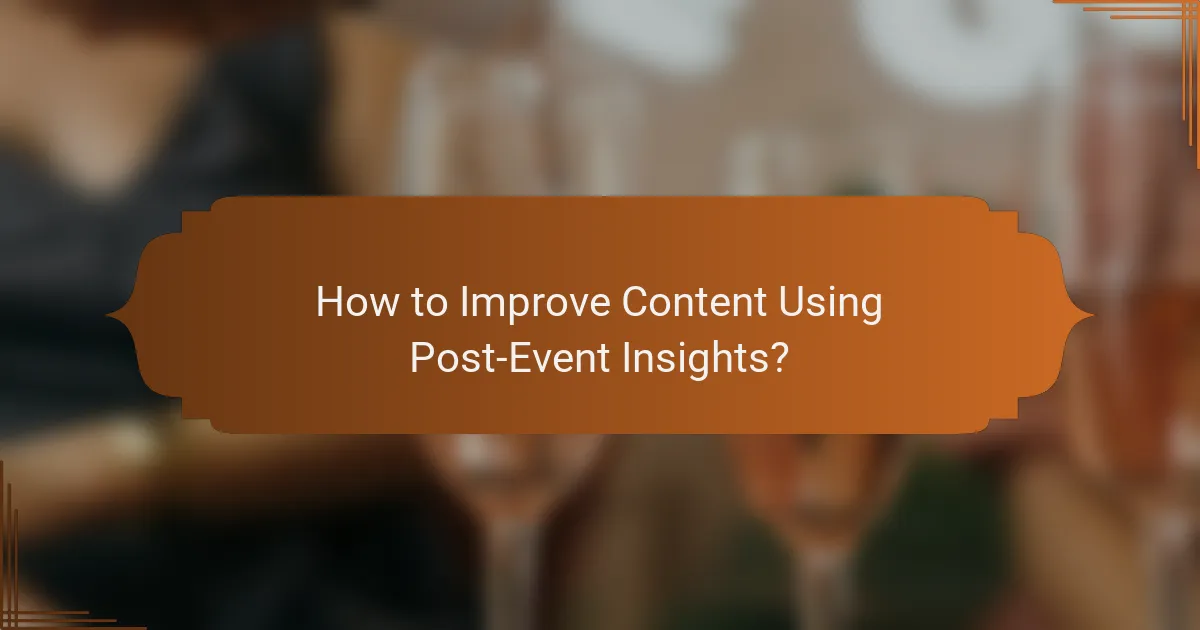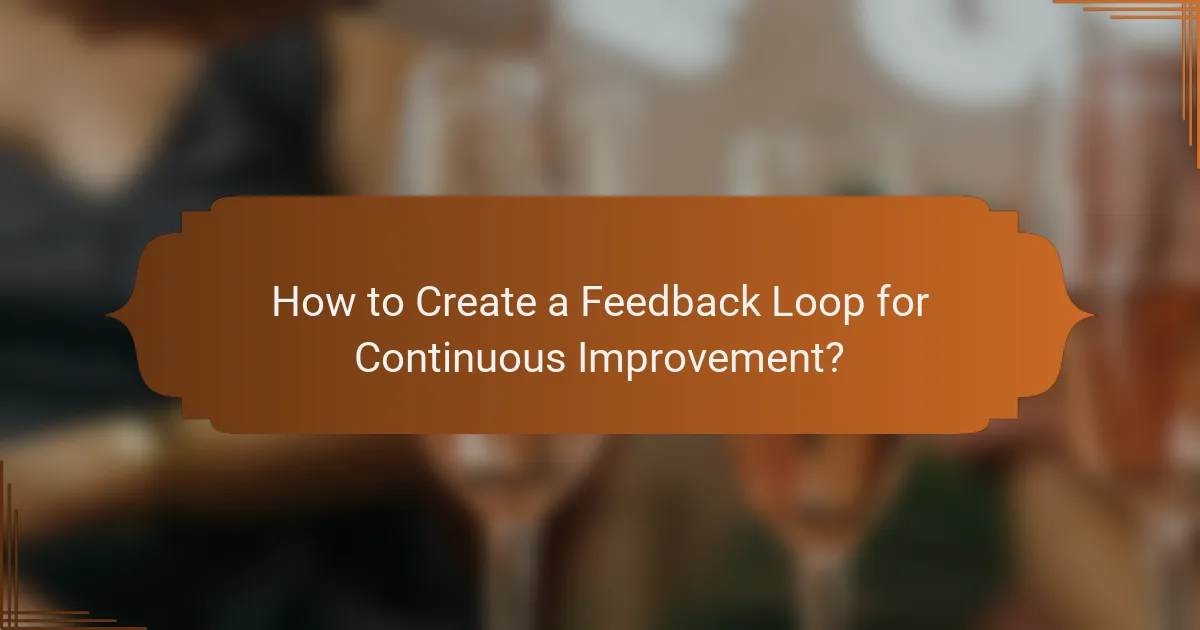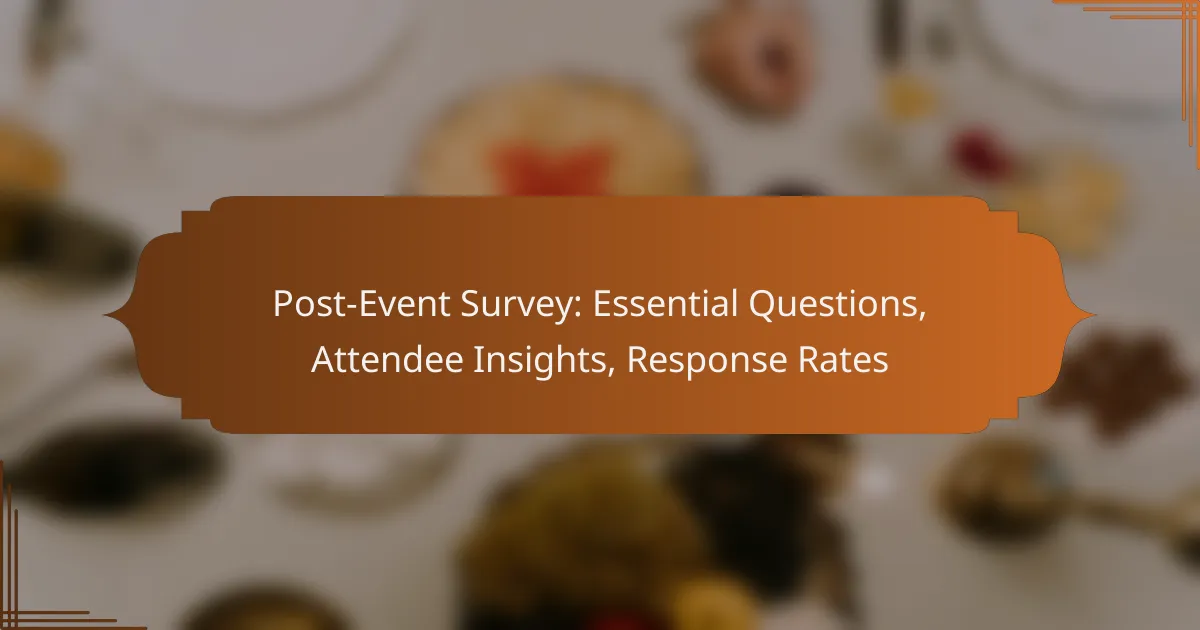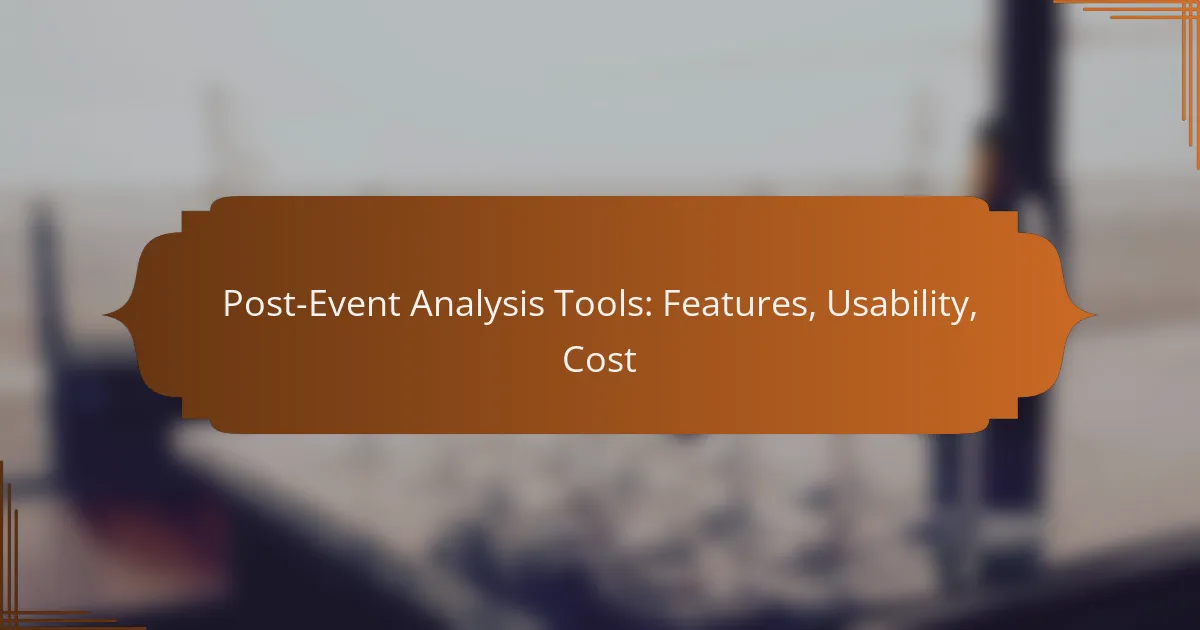Leveraging post-event data is crucial for refining marketing strategies and enhancing audience engagement. By analyzing attendee behavior and feedback, marketers can optimize their targeting techniques and improve content effectiveness for future campaigns. This data-driven approach not only maximizes impact but also ensures that marketing efforts resonate more deeply with specific audience segments.

How to Utilize Post-Event Data for Marketing Strategies?
Utilizing post-event data for marketing strategies involves analyzing attendee behavior and feedback to refine future campaigns. This data can enhance targeting, improve content, and optimize overall marketing effectiveness.
Data-driven campaign optimization
Data-driven campaign optimization focuses on using insights gathered from post-event analytics to refine marketing efforts. By examining metrics such as engagement rates, conversion statistics, and attendee demographics, marketers can identify what worked well and what didn’t.
Consider A/B testing different messaging or channels based on this data. For example, if a specific email campaign yielded higher open rates, similar strategies can be employed in future outreach to maximize effectiveness.
Personalized customer engagement
Personalized customer engagement leverages post-event data to tailor interactions with attendees. By analyzing individual preferences and behaviors, marketers can create customized follow-ups that resonate with each participant.
For instance, sending targeted content based on session attendance can significantly increase engagement. If a participant showed interest in a particular topic, providing additional resources or invitations to related events can foster a stronger connection.
Targeted advertising strategies
Targeted advertising strategies utilize insights from post-event data to reach specific audience segments effectively. By understanding attendee profiles, marketers can create ads that speak directly to the interests and needs of those segments.
For example, if data reveals that a large portion of attendees are small business owners, ads highlighting products or services tailored for that demographic can be deployed across relevant platforms, enhancing the likelihood of conversion.
Performance analysis and reporting
Performance analysis and reporting involve assessing the outcomes of marketing strategies post-event to gauge success and areas for improvement. This includes compiling data on key performance indicators (KPIs) such as ROI, lead generation, and attendee satisfaction.
Creating a detailed report that outlines these metrics helps in making informed decisions for future events. Regularly reviewing performance data allows marketers to adapt strategies quickly, ensuring continuous improvement in their marketing efforts.

What Audience Targeting Techniques Can Be Applied?
Audience targeting techniques are essential for maximizing the impact of marketing efforts post-event. By analyzing attendee data, marketers can tailor their strategies to engage specific segments effectively.
Segmentation based on event interactions
Segmentation involves categorizing attendees based on their interactions during the event, such as session attendance, booth visits, and engagement levels. This allows marketers to identify high-interest groups and craft messages that resonate with their experiences.
For instance, attendees who participated in workshops may be more interested in follow-up content related to those topics. Segmenting by interaction can lead to more personalized communication, increasing the likelihood of conversion.
Behavioral targeting for improved relevance
Behavioral targeting focuses on the actions attendees took before, during, and after the event. By analyzing behaviors, marketers can predict future interests and tailor their outreach accordingly.
For example, if a segment frequently engages with content about sustainability, targeted emails featuring eco-friendly products or initiatives can be sent. This approach enhances relevance and fosters deeper connections with the audience.
Demographic analysis for tailored messaging
Demographic analysis examines characteristics such as age, gender, location, and profession to refine messaging strategies. Understanding these factors helps marketers create content that speaks directly to the needs and preferences of different groups.
For example, younger attendees may respond better to digital content, while older demographics might prefer traditional communication methods. Tailoring messaging based on demographics can significantly improve engagement rates and overall campaign effectiveness.

How to Improve Content Using Post-Event Insights?
Improving content with post-event insights involves analyzing data collected during and after an event to enhance future content strategies. By leveraging performance metrics, audience feedback, and trend analysis, marketers can create more targeted and effective content that resonates with their audience.
Content performance evaluation
Content performance evaluation focuses on assessing how well your content engaged the audience during the event. Key metrics to consider include views, shares, and engagement rates, which can provide insights into what resonated with attendees.
To evaluate performance effectively, compare content types (e.g., videos, articles, social posts) and their respective engagement levels. For instance, if video content received significantly more shares than written articles, consider increasing video production for future events.
Audience feedback integration
Integrating audience feedback is crucial for refining content strategies. Collect qualitative data through surveys, polls, or direct comments to understand what attendees liked or disliked about the content presented.
For example, if feedback indicates that attendees found certain topics particularly valuable, prioritize those subjects in future content. Additionally, consider implementing a follow-up survey post-event to gather more structured insights.
Trend analysis for future content
Trend analysis involves examining patterns in audience behavior and preferences over time. By identifying recurring themes or topics that generate interest, marketers can tailor future content to align with these trends.
Utilize tools like Google Trends or social media analytics to track popular topics related to your industry. For example, if data shows a rising interest in sustainability, incorporate this theme into upcoming content to attract and engage your audience effectively.

What Metrics Should Be Tracked After Events?
Tracking metrics after events is crucial for understanding their impact and improving future strategies. Key metrics include engagement rates, conversion tracking, and customer retention metrics, each providing insights into different aspects of event performance.
Engagement rates
Engagement rates measure how actively participants interacted with your event content. This can include metrics such as session attendance, social media interactions, and post-event surveys. High engagement rates typically indicate that the content resonated well with the audience.
To calculate engagement rates, consider the total number of interactions divided by the total number of attendees. For example, if 200 out of 1,000 attendees interacted with your content, the engagement rate would be 20%. Aim for engagement rates above 15% for a successful event.
Conversion tracking
Conversion tracking focuses on how many attendees took desired actions after the event, such as signing up for a newsletter or making a purchase. This metric is essential for assessing the effectiveness of your marketing strategies and the event’s overall ROI.
To effectively track conversions, set clear goals before the event and use tracking tools like Google Analytics or CRM systems. For instance, if you aim for a 10% conversion rate and 100 attendees convert out of 1,000, you’ve met your goal. Regularly analyze these figures to refine your approach.
Customer retention metrics
Customer retention metrics evaluate how well you maintain relationships with attendees after the event. This can include repeat attendance, customer loyalty scores, and feedback ratings. High retention rates suggest that your events are valuable and foster long-term relationships.
To measure retention, track the percentage of attendees who return for future events or engage with your brand within a specified timeframe. For example, if 300 out of 1,000 attendees return for another event, your retention rate is 30%. Focus on building community and providing value to enhance these metrics.

How to Create a Feedback Loop for Continuous Improvement?
Creating a feedback loop involves systematically gathering and analyzing data from your audience to enhance future events and marketing strategies. This process ensures that insights are continuously fed back into your planning and execution phases, leading to ongoing improvements.
Surveys and polls for audience insights
Surveys and polls are effective tools for collecting audience insights after an event. They can be distributed via email, social media, or directly on your event platform, allowing attendees to share their experiences and suggestions. Aim for a response rate of at least 20-30% to ensure your data is representative.
When designing surveys, focus on both quantitative and qualitative questions. Use rating scales for specific aspects like content quality or speaker effectiveness, and open-ended questions for deeper insights. Keep surveys concise to encourage completion, ideally taking no more than 5-10 minutes.
Data collection strategies post-event
Post-event data collection strategies should encompass various methods to capture comprehensive feedback. In addition to surveys, consider leveraging social media analytics, website traffic data, and direct feedback from event staff. Each of these sources can provide unique insights into audience engagement and satisfaction.
Utilize tools like Google Analytics to track user behavior on your event website, and monitor social media mentions to gauge public sentiment. Combining these data points can help identify trends and areas for improvement. Regularly review and analyze this data to inform your future marketing strategies and event planning.

What Tools Can Enhance Post-Event Data Analysis?
Several tools can significantly enhance post-event data analysis by providing insights into attendee behavior, engagement, and overall event performance. Utilizing analytics platforms, CRM systems, and survey tools can help marketers refine their strategies and improve future events.
Analytics Platforms
Analytics platforms, such as Google Analytics or Tableau, allow marketers to track and analyze data from various sources. These tools can provide insights into attendee demographics, session popularity, and engagement levels. By examining this data, marketers can identify trends and adjust their strategies for future events.
For example, if a particular session has high engagement metrics, it may indicate a topic of interest that should be expanded upon in future events. Conversely, low engagement can signal a need for content improvement or a different approach to marketing.
CRM Systems
Customer Relationship Management (CRM) systems, like Salesforce or HubSpot, help organizations manage attendee information and interactions. By integrating post-event data into these systems, marketers can segment their audience based on behavior and preferences, enabling targeted follow-up campaigns.
For instance, attendees who engaged with specific sessions can be sent tailored content or offers related to those topics. This targeted approach can increase conversion rates and foster stronger relationships with attendees.
Survey Tools
Survey tools, such as SurveyMonkey or Typeform, are essential for gathering direct feedback from attendees after an event. These tools can help marketers understand attendee satisfaction, areas for improvement, and suggestions for future events.
Implementing post-event surveys can yield valuable qualitative data that complements quantitative analytics. Aim for a response rate of around 20-30% to ensure the feedback is representative. Use this information to refine content and enhance the overall attendee experience in future events.



